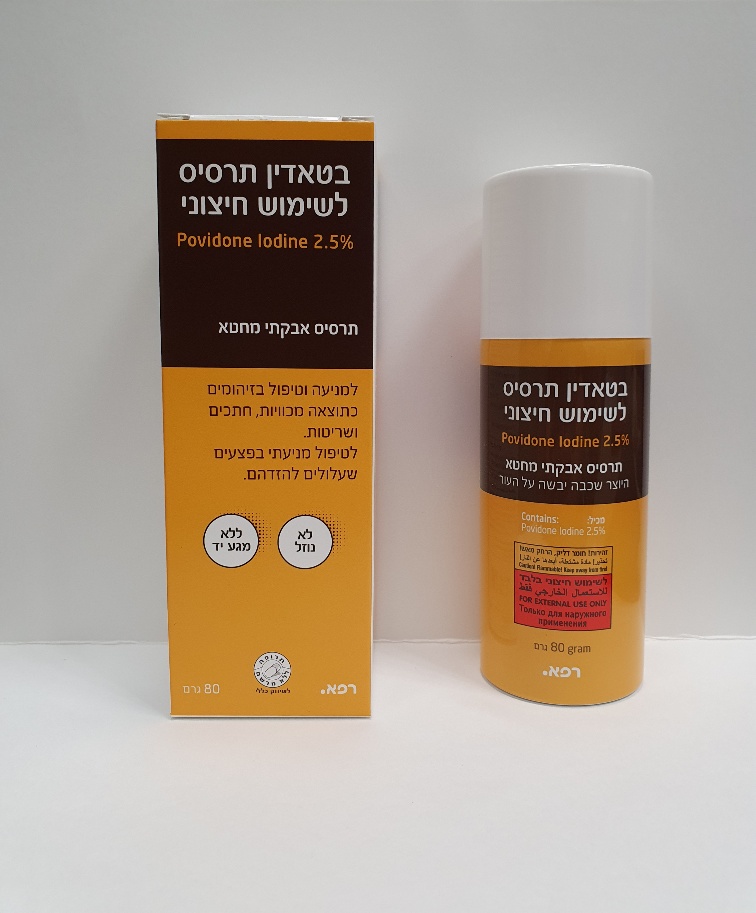Quest for the right Drug

בטאדין תרסיס לשימוש חיצוני BETADINE TOPICAL SPRAY (POVIDONE-IODINE)
תרופה במרשם
תרופה בסל
נרקוטיקה
ציטוטוקסיקה
צורת מתן:
עורי : DERMAL
צורת מינון:
אין פרטים : CUTANEOUS SPRAY, POWDER
עלון לרופא
מינוניםPosology התוויות
Indications תופעות לוואי
Adverse reactions התוויות נגד
Contraindications אינטראקציות
Interactions מינון יתר
Overdose הריון/הנקה
Pregnancy & Lactation אוכלוסיות מיוחדות
Special populations תכונות פרמקולוגיות
Pharmacological properties מידע רוקחי
Pharmaceutical particulars אזהרת שימוש
Special Warning עלון לרופא
Physicians Leaflet
Pharmacological properties : תכונות פרמקולוגיות
Pharmacodynamic Properties
5.1. Pharmacodynamic Properties Pharmacotherapeutic group: Antiseptics and disinfectants, iodine products, povidone-iodine ATC code: D08AG02 Povidone-iodine is a complex of the polymer polyvinylpyrrolidone with iodine (povidone-iodine). The microbicidal effect of povidone-iodine is based on its share of free iodine without complex binding, which is being released from the povidone-iodine complex by an equilibrium reaction. Hence, the povidone-iodine complex represents an iodine depository providing for the sustained release of elementary iodine and ensuring a constant concentration of active free iodine. By its binding to the povidone-iodine complex, iodine largely loses the local irritant properties being characteristic of alcoholic iodine preparations and thus shows good tolerability for skin, mucous membranes and wounds. The free iodine reacts with oxidizable SH or OH groups of the amino acids in enzymes and structural proteins of microorganisms thereby inactivating and killing these enzymes and proteins. During this process iodine is discolored; thus, the intensity of brown coloration serves as indicator of its effectiveness. Redosing is required upon discoloration. This rather unspecific mechanism of action explains the extensive activity of povidone-iodine against a broad spectrum of human pathogens: gram-positive and gram-negative bacteria, Gardnerella vaginalis, mycoplasmas, Treponema pallidum, chlamydiae; fungi (e.g. Candida), viruses (including Herpes and HIV); protozoae (e.g. trichomonads) and spores. Because of this mechanism of action resistances, including secondary resistance upon prolonged use, are not to be expected.
Pharmacokinetic Properties
5.2. Pharmacokinetic Properties After use of Betadine Topical Spray, the possibility of iodine absorption must be considered; this absorption will depend on the kind and duration of use and on the amount applied. Prolonged application of Betadine Topical Spray on extensive wounds and burns or on mucous membranes may result in substantial iodine uptake. In general, the resultant increase of iodine level in blood is only transient (restitution within 7-14 days after discontinuation of treatment). In patients with normal thyroid function, the increased iodine supply does not cause any clinically significant relevant changes in thyroid hormone status. Povidone: Absorption and, in particular, renal elimination of povidone is dependent on the (mean) molecular weight (of the mixture). For a molecular weight of more than 35,000 to 50,000 dalton, retention, must be anticipated, especially in the reticulohistiocytic system. However, the saurismosis and other changes as seen after intravenous or subcutaneous administration of other povidone containing drugs are not seen for povidone-iodine. Iodine: Absorption after topical application to the skin: After short exposure, absorption is limited on intact skin. The application to damaged skin, e.g., wounds or burns, results in increased absorption. The behavior of absorbed iodine or iodide in the organism is largely similar to that of iodine taken up by other routes. The volume of distribution is about 38% of body weight in kg; a biological half-life of approx. 2 days has been described after vaginal administration. The normal value for total iodine in serum is about 3.8 to 6,0 μg/dl, and about 0.01 to 0.5 μg/dl for inorganic iodine. Elimination is almost exclusively by renal route with a clearance of 15 to 60 ml plasma/min depending on serum-iodine level and creatinine clearance (normal value: 100-300 μg iodide per g creatinine).

שימוש לפי פנקס קופ''ח כללית 1994
לא צוין
תאריך הכללה מקורי בסל
לא צוין
הגבלות
לא צוין
מידע נוסף
